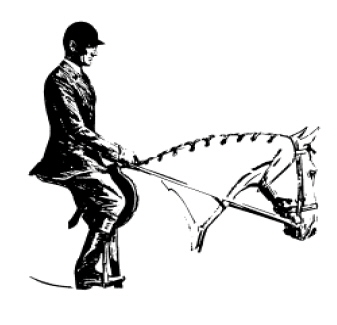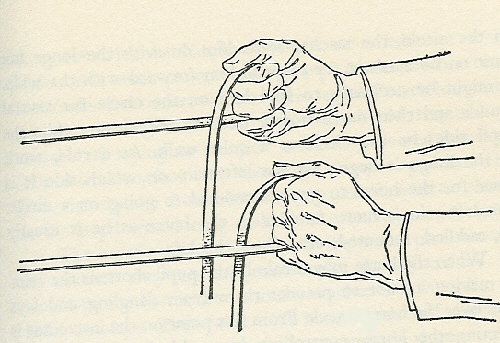IMEHA (International Model Equine Hobbyists Association) was an online photo showing site that existing until 2018. Included on the site were these guidebooks for judging and showing model horses in Performance classes. MEPSA has obtained permission to share the info contained in the guides.
Scoring :: Point Deducts :: Tack :: Rider :: Set-Up Options :: Photo Examples
This class is seen only in the model horse hobby. It is written for those people who wish to compete in trail class but do not have arena wall props. Class requires an obstacle. Some rulings, attire and equipment may be relaxed slightly. Natural trail classes are judged under the same rules and with the same requirements as Arena Trail but are held outside of the arena using natural obstacles such as creeks, ponds, uphill and downhills slopes, ditches fallen trees, bushes, pasture gates, etc. The natural trail class should be judged on realism, imagination, and the horse’s apparent ability to provide a safe and pleasurable ride. Any English style tack and any attire permitted. Unsafe equipment may be penalized at the judge’s decision. Any misbehavior should be penalized, including but not limited to shying, bucking, rearing, fighting the bridle, being above the bit, jumping or leaping away of the obstacle.
No cross entering using the same photo for both English Trail Natural and Hunter Under Saddle Natural – No Rail Fence. English Trail Natural requires an obstacle and Hunter Under Saddle Natural should have no obstacle in the photo.
A horse should demonstrate a willing walk and calmly work over and through all obstacle, showing agility, in control of the rider and on the bit, balance, and ready responsiveness. Horses that shy, pace, above the bridle or otherwise demonstrating excitement or lack of control are not suitable for trail natural. A trail horse should, however, not be a dead head but should show interest in the obstacles. A trail obstacle represents a test and the horse is judged on how well it is meeting that test. The obstacle may test calmness, agility or control. All obstacles test willingness and obedience. Credit will be given to horses negotiating the obstacles with style and some degree of speed, providing correctness is not sacrificed. Horses should receive credit for showing attentiveness to the obstacles and the capability of picking their own way through the course when obstacles warrant it, and willingly responding to the rider’s cues on more difficult obstacles. Gaits are halt, walk, trot, canter and back.
You Score English Trail Natural on the following basis:
Obstacles:
Creeks
Ponds
Uphill and downhills slopes
Ditches
Fallen Trees
Bushes
Pasture Gates
Tires
Animal Contact
Dismounting
Jumps
Rocking, moving or railed bridges
Water box with floating or moving parts
Ground ties
Any other type natural obstacle or experience outside of an arena
You Score English Trail Gaits on the following basis:
Faults to be scored according to severity:
(1) Quick, short or vertical strides
(2) Being on the wrong lead
(3) Breaking gait
(4) Excessive speed at any gait
(5) Excessive slowness in any gait, loss of forward momentum
(6) Failure to take the appropriate gait when called for
(7) Head carried too high
(8) Head carried too low (such that poll is below the withers)
(9) Overflexing or straining neck in head carriage so the nose is carried behind the vertical
(10) Excessive nosing out
(11) Failure to maintain light contact with horse’s mouth
(12) Stumbling
(13) If a horse appears sullen, dull, lethargic, emaciated, drawn or overly tired
(14) Consistently showing too far off the rail
Faults which will be cause for disqualification, except in novice amateur or novice youth, which shall be faults scored according to severity:
(1) Head carried too low (such that poll is below the withers consistently)
(2) Overflexing or straining neck in head carriage so the nose is carried behind the vertical consistently
At the option of the judge, all or just the top 12 horses may be required to hand gallop, one or both ways of the ring. Never more than 12 horses to hand gallop at one time. At the hand gallop, the judge may ask the group to halt and stand quietly on a free rein (loosened rein).
If You Use A Doll Rider:
Rider should have a workmanship appearance, seat and hands, light and supple. Hand should be over and in front of horse’s withers, knuckles 30 degrees inside the vertical, hand slightly apart and making a straight line from the horse’s mouth to rider’s elbow. Method of holding reins is optional. All reins are to be picked up at the same time. Eyes should be up with shoulders back, toes slightly out and ankles flexed in. Heels should be down and calf or leg in contact with horse and slightly behind girth.
The rider should sit in a comfortable, balanced, and relaxed manner while maintaining an erect upper body with eyes up and looking forward.
The rider’s legs should have a slight bend and hang beneath the rider such that when viewed from a profile, a straight line (approximately) can be drawn through the rider’s ear, shoulder, hip and heel.
The irons should be placed under the balls of the feet and not under the toe or against the heel.
Toes should be turned only slightly out with ankles flexed in toward the horse.
The lower leg should be held such that light contact would be maintained with the horse.
Arms and hands should be held in a comfortable, relaxed manner with upper arms held in a straight line with the body. The elbow is bent such that the lower arm and hands are in a straight line to the bit.
Hands should be slightly over and in front of the withers with knuckles 30 degrees inside the vertical.
Position in Motion;
At the walk and slow trot, body should be vertical with slight motion in the saddle.
At a posting trot, the body should be inclined forward with slight elevation in the saddle.
At the canter, the body should be halfway between the posting trot and the walk.
At the gallop, and while jumping, the body should be at a similar inclination as when at a posting trot.
Extra Credit Should Be Given If:
(1) Rein contact is steady but gentle at all times. It is referred to as ‘direct contact’ On a model entry this can be achieved by using sticky wax and makes the rein go in a direct straight line from the bit to the rider’s hand with no slack in the rein.
(2) Bight (Excess rein) of rein is draped on the right.
(3) Mane and tail braided with complementary color also should receive extra credit.
(3) an Entry Number is shown on saddle blanket or on rider’s back.
Points Should Be Deducted If:
(1) Model exhibits excessive speed for gait assigned.
(2) Model is on the wrong lead.
(3) Model appears to display a slowness in any gait or loss of forward momentum resulting in an animated and/or artificial gait at the lope.
(4) Rider Touches horse or saddle with free hand.
(5) Model’s head is carried too high.
(6) Model’s head carried too low; tip of ear below the withers.
(7) Model is over flexed or has a strained neck in head carriage, so the nose is carried behind the vertical.
(8) Model displays excessive nosing out.
(9) Model displays an open mouth excessively.
(10) Rider uses spurs forward of the heart girth.
(11) Model appears sullen, dull, lethargic, emaciated, drawn or overly tired.
(12) Model appears agitated; has ears back, tail twirled, etc.
(13) Model displays quick, choppy or pony strides.
(14) Reins are draped and not a direct contact.
Required Tack:
Forward seat saddle with a string or leather girth and bridles of matching leather with a cavesson noseband and bit, usually a snaffle bit. Most bits are legal however (snaffles of all types, pelhams and double bridles), it is assumed however that the rider is not relying upon a strong bit to control the horse, therefore a snaffle is recommended for this class. In most countries horses are shown with a white fitted saddle pad (called a numnah) in England though horses are shown without one and just the bare saddle on the horse’s back. On the West Coast in California is style of riding without a pad under the saddle is also often seen. Stock Hunt Bridles generally have a white lining under the browband and noseband under the leather on the bridle. Bridles may be laced, braided or plain. Entries are often braided (usually on the right side of neck). Breast plates and cruppers are legal tack for Hunter Under Saddle, but their presence indicates that the horse is less than ideally shaped and therefore requires mechanical assistance to keep the saddle in position. Showers should be discouraged from using these items for the ‘effect’.
Saddleseat may also be used
Prohibited Tack:
Boots, Martingales, Side Reins, Rein Stoppers, Figure-8, Flash and Drop Nosebands or other devices for controlling the headset are forbidden.
Rider:
Because a hunt seat doll is very hard to get in the correct position it often detracts from a good entry more than enhancing it. The best doll to use to get in the correct position is a Mego fully jointed doll. Breyer dolls just can’t cut it. Whatever doll you use it should be not only be in the correct positioned for the gait with good rein contact but should be dressed in black, brown tweed, brown, dark green or navy blue hunt coat, light shirt with choker (stock pin optional, monograms fashionable) light-colored beeches (no white) with full boots or beige jophpurs with jodhpur boots, hard hat and any long hair should be tied up in a bun or hairnet. Shadbelly coats, bright colors, top hats, and bowlers are not seen (except male riders may wear bowlers if they are wearing tweed or casual ring attire.) This style is appropriate for European entries. Riders may also wear uniforms from Riding Schools just as Spanish Riding School, Oxford Riding School, French Calvary School, etc. The uniform would consist of beeches, uniform jacket, school hat or cap, full boots and white gloves.
Saddle seat attire when using a saddleseat.
Set-Up Options:
No Arena Fencing Allowed
Obstacle Required
Footing Required:
- Dirt
- Sand
- No rock base
Backboard or Natural Setting (Outdoor only)
Examples of the English Trail Natural:
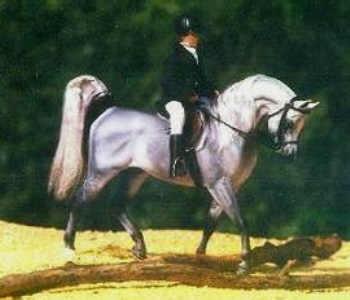
English Trail Natural
Arabian Breed Entry
Datelis Amadeus shown as a Grey Arabian Stallion and is a King’s Ransom Resin. Shown by Betty Hook with the comment of: Stepping over fallen log while on a pleasure ride.

English Trail Natural
TB/WB or Sporthorse Breed Entry
Aer Charmed Life shown as a Chestnut Hanoverian Stallion and is a CM Breyer Jumper by Jen Read. shown by Andrea Robbins with the comment of: Pleasure riding in nature.
Doll Rider Correct Seat and Hold the Reins Correctly:

The reins are held between the ring fingers and pinkies with the thumbs solidly on top as they exit the hands. The grip is firm. Close the fingers for optimum communication and safety. Hold the hands just above the horse’s withers, in front of the saddle. Tip the thumbs toward each other at a 45-degree angle. Bend the elbows just enough to create a straight line through the forearms, hands, and reins to the horse’s mouth.
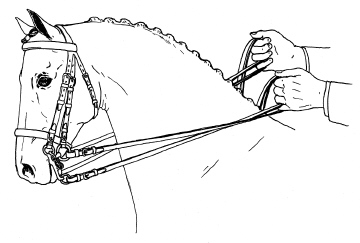
Double Bridle Reins – 2 and 2 Method. Most common handle hold in model horse hobby. It is advised that you put in your comment line what hold your set up is so that judge’s know you understand the three styles on holding the reins.

Double Bridle Reins – 3 in 1 Method. A true challenge for model horse hobbyists and doll rider’s with razor cut slips in the fingers of the hands. Left side curb goes directly back to hand and enters under ring finger with the left snaffle rein coming directly back and entering under the pinky finger with rein crossing over the curb rein. Right side curb rein goes directly back and enters under the middle finger of the left hand with all three reins coming up thru hand and out over the of the index finger with bight cascading down the right side. The right side snaffle goes directly and enters the hand under the ring finger, up into the hand and out over the top of the index finger with the bight draping down the right side. The look gives an ‘X’ to reins the left side of horse’s neck but a two independent rein look to the right side but only one rein going into the right hand. Very tricky set up.
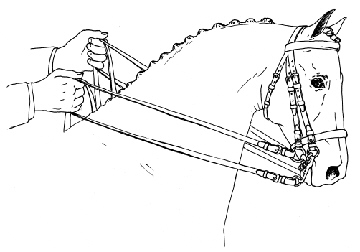
Double Bridle Reins – Fillis Method. The Fillis method of holding the reins is when the curb reins enter the rider’s hand from the bottom, around the little fingers and up to the second joint of the index fingers while the snaffle enters the fist from above over the index fingers. Each hand holds two reins.

